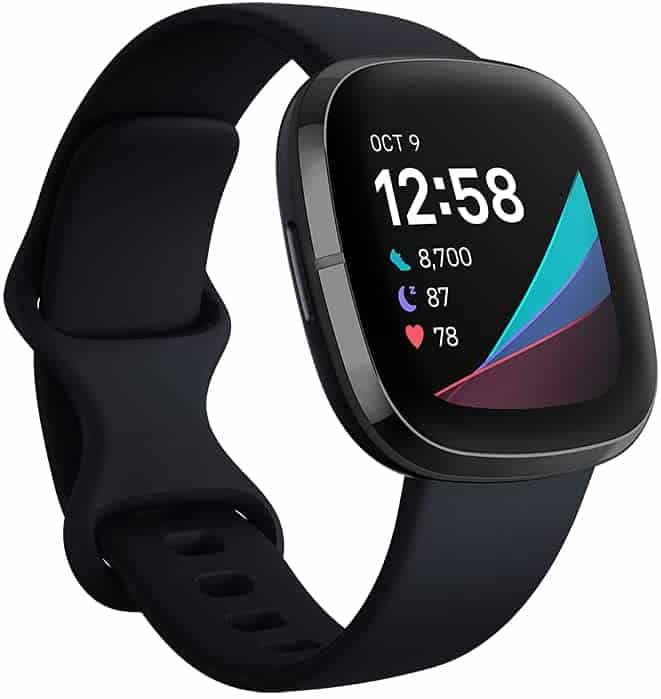Last Updated on
The Fitbit Versa 3 and Fitbit Sense are the company’s two most recent smartwatches, and while they appear to be quite identical on the outside, they contain substantial differences.
The Fitbit Sense health watch has an electrocardiogram (ECG), stress detection, and a skin temperature sensor. While the Versa 3 lacks all of these features, it does have SpO2 monitoring, GPS tracking, and all of the normal Fitbit tracking. In essence, it is the Sense without the added frills.
If you are stuck choosing between these two options then you have come to the right place. Here are the biggest differences and most important features of both the Fitbit Sense and Versa 3.
Health Tracking
While the design of these two watches is practically identical, it is in this area that substantial differences can be seen. Because the Sense is Fitbit’s health watch, it will track and monitor more than steps and sleep.
Both gadgets use Fitbit’s latest PurePulse 2.0 optical heart rate sensor and a new temperature sensor.
According to Fitbit, PurePulse 2.0 provides more accurate heart rate tracking than previous Fitbit devices.
Additionally, both devices can detect your body temperature, though this information is only visible to Premium Members.
Both devices have a SpO2 sensor, which displays the SpO2 range during the night alongside sleep data. Fitbit Premium users may now track blood oxygen trends as well.
Women’s cycle tracking is integrated, and critical insights are accessible via both the watch and the accompanying phone app.
As part of the Fitbit OS 5.2 upgrade, which will come in June 2021, the Versa 3 now receives high/low heart rate notifications – and you can check nightly SpO2 measurements without using the specialized SpO2 watch face.
The Sense – Unique Features
The Sense accomplishes the same thing as the Versa 3 but includes an ECG app that lets users acquire medical-grade heart rate readings to help in the diagnosis of conditions such as atrial fibrillation (afib).
The Sense makes use of the PPG sensor to generate high and low heart rate warnings if your heart rate rapidly increases or decreases while you are at rest.
Additionally, Sense now has a new EDA Scan software that is optimized for stress detection.
When you place your hand on the watch, it detects minute electrical changes in the sweat level on your skin to evaluate your body’s response to stress.
Also, the Fitbit Sense will monitor for additional stress indicators and will calculate a Stress Score using several data points designed to assess physiological signals of stress.
This is linked to an emotional state questionnaire and contains mindfulness content, guided meditations, and breathing exercises to aid you in overcoming negative feelings.
In a nutshell, if you’re searching for a watch with advanced health monitoring features and cutting-edge sensors, the Sense is the one for you!
Sports Tracking
Fitbit’s two new smartwatches continue to track step, sleep, and heart rate 24 hours a day — and also include a variety of sports tracking features.
The good news is that both watches have an accelerometer capable of measuring indoor activities such as treadmill jogging and steps.
Fitbit’s tracking capabilities are superior at tracking sleep, and both devices provide insights into sleep stages and a Sleep Score to help you better understand your overall sleep quality.
As previously indicated, both devices will use the SpO2 sensor to measure blood oxygen levels during sleep.
Both devices use Fitbit’s newest PurePulse 2.0 heart rate sensor, which the firm claims improves the accuracy of the previous generation sensor.
This is used to continually monitor your heart rate, exercise in heart rate zones, and check your Active Zone Minutes to ensure your heart is pumping regularly.
Additionally, it enables users to view activity intensity maps, which highlight the most demanding areas of a running or cycling route.
The Versa 3’s inbuilt GPS and GLONASS satellite technology enable outside monitoring, while swim tracking (which is still restricted to the pool) is available on both the Versa 3 and the Sense.
Additionally, an altimeter is included for measuring height, and the 20+ training modes include automatic activity identification for a range of activities.
These two smartwatches are inseparable when it comes to fitness and sports tracking.
SmartWatch Features
When it comes to sports and fitness tracking, the Versa 3 and Sense provide a comparable experience when utilizing their smartwatch features.
These watches connect to Android and iPhone devices, allowing you to monitor your phone’s notifications, as well as download faces for your watch and applications.
Pay with Fitbit Pay, and listen to music from your collection or supported services such as Deezer and Pandora.
Both watches have a digital assistant in the form of Alexa or Google Assistant – the latter of which is now only accessible in the United States, with a wider rollout scheduled for the end of the year.
Fitbit augments the Versa 2’s microphone with a speaker. This adds the ability to handle phone calls from either watch, which Fitbit OS 5.1 enables.
This function is available only when your smartwatch is near you, as it relies on Bluetooth communication. Android users may also respond to text messages by voice. .
This microphone is also used by Fitbit’s new smart assistant, Google Assistant, which joins Amazon’s Alexa to provide users with a choice of two assistants to manage their requests and inquiries.
Summary – Which Should You Buy?
Almost everything about the Fitbit Sense and the Versa 3 is identical, except when it comes to the health features.
If you are most concerned about health tracking, then the Fitbit Sense is the watch for you. If you want a bit more of a simple product, then you will be fine with the Versa 3.





